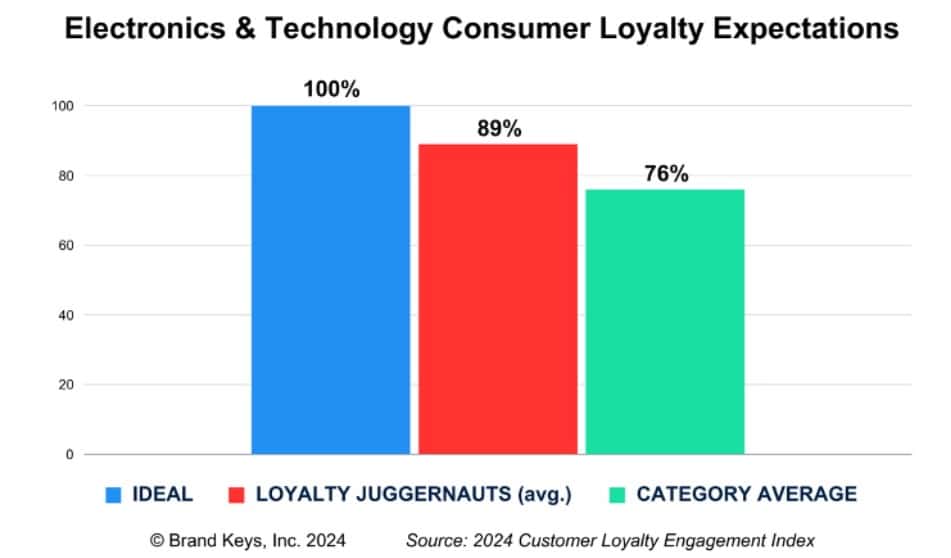The concept of brand loyalty has become almost as complicated as coming up with a strategy to earn it. The number of variables that determine loyalty—any one of which can likewise destroy a consumer’s sense of loyalty if mishandled—are changing quickly and often, and brand marketers often have to revamp their approach as soon as it starts working.
One firm that has been watching these changes closely over the years is loyalty and customer engagement firm Brand Keys, which just released its 27th annual Customer Loyalty Engagement Index (CLEI) assessments. In addition to recognizing the loyalty leaders in a variety of product categories, the firm takes a deep dive into what impacts loyalty today, along with takeaways for brands to incorporate into their marketing strategies. Here’s a look at their findings and analysis for the category of consumer electronics.
“This year’s roster proves meeting or exceeding consumers’ expectations allows brands to transmute market-share and loyalty into category and market dominance. Those brands are ‘Loyalty Juggernauts’—brands of such overwhelming economic force that their ability to meet expectations makes them far more powerful than universal awareness alone,” said Robert Passikoff, Brand Keys founder and president, in a news release.

Electronics & tech brand loyalty juggernauts
The model applies to all sectors and categories where brands generate high levels of consumer engagement and loyalty by better meeting consumers’ expectations. Doing that can turn a brand into a devastating economic force. This year, Loyalty Juggernauts include the following brands, with percentages indicating their ability to meet expectations consumers hold for the Ideal (100 percent) in their category:
- File Sharing: Dropbox (91 percent)
- Headphones: Apple (91 percent)
- Laptop: Samsung (88 percent)
- Tablet: Apple (94 percent)
- Video Games: FIFA 23 & Hogwarts Legacy (87 percent)
- Printers: HP (83 percent)
- E-Reader: Kindle (86 percent)
- MFP Copier: Konica Minolta (90 percent)
- Flat Screen TV: Samsung (93 percent)
- Smartphone: Apple (95 percent)
- Instant Messaging: WhatsApp (88 percent)
Loyalty works differently today
“The loyalty paradigm has changed dramatically since the Cola Wars of the ’70s,” said Passikoff. Today, loyalty—and consumer choice—don’t come down to one-or-the-other options. Today’s loyalty bottom-line comes down to consumers’ deepest expectations, and how they feel which brand measures up best. “Customer behavior and brand loyalty are now almost entirely governed by emotional values related to expectations, and expectations grow constantly,” said Passikoff. “This year’s results validate customer expectations as the most accurate and predictive loyalty indicators, proving conclusively that better addressing consumer expectations turn everyday-brands into ‘Loyalty Juggernauts.’”
This year’s CLEI also makes it clear that consumers will not simply settle
Their emotional expectations are the hardest to measure, but that is why they are the most valuable. In this year’s survey electronics and technology brand category expectations increased 54 percent YOY, but most brands have only kept up on average by 11 percent. Loyalty Juggernauts reduce that gap up to 50 percent, thereby virtually guaranteeing ongoing and consistent customer loyalty.
The ‘super glue’ of customer loyalty
Being a Loyalty Juggernaut moves brands beyond primacy-of-product, distribution, ad budgets, and even pricing. It essentially commands category leadership. “The ability to meet those very high consumer expectations better than the competition acts like the ‘super glue’ of loyalty,” said Passikoff. “Brands create a virtually unbreakable bond with customers.”
The economics of loyalty
“Identify what consumers expect, create strategies, advertising and experiences that meet those expectations, and your brand can transform into a Loyalty Juggernaut,” said Passikoff. “Customers will be six times more likely to engage, buy and buy again. They are six times more likely to think of you first, pay more attention to your marketing and social networking activities and actively engage with your brand. That’s the real payoff—blockbuster category leadership and more effective marketing.”
A few 2024 economic facts substantiate the cost-and-effort effectiveness of brand loyalty strategies:
- It costs 16 times more to recruit a new customer than keep an existing one.
- A 5 percent increase in loyalty lifts lifetime profits per customer as much as 78%.
- A 5 percent loyalty-increase is equal to a 12-21% across-the-board cost reduction program.
Recognizing real loyalty
The results of the 2024 CLEI offer up something more concrete than the accumulation of points and more to actual behavior in the marketplace. “Real loyalty isn’t as nebulous as you might think,” said Passikoff. “Unfortunately, it isn’t something that just visits itself upon your brand. It’s not awareness, not satisfaction. It isn’t something you find on a 10-point scale. Those metrics only allow brands to bask in mediocrity.”
Loyalty is more complex in the same way the consumer and marketplace have become more complex. Loyalty is the consumer-to-brand bond, the bridge between emotional engagement and ensuring future purchases. From a measurement perspective, it’s the degree to which a brand meets expectations that consumers hold for the ideal product or service in its category. It’s the ultimate answer to the question, “Do you know what consumers truly desire—and how well does your brand deliver on those expectations?”
See the complete list of the 2024 CLEI Brand Juggernauts in their categories here.
For the 2024 CLEI survey, 95,607 US consumers, 16 to 65 years of age self-selected categories in which they are consumers and assessed brands for which they are customers. This year, Brand Keys examined 1,200 brands in 114 categories to identify four category-specific path-to-purchase behavioral loyalty drivers, each driver’s component values and their percent-contribution to engagement, loyalty, and profitability (assessments that correlate with positive consumer behavior in the marketplace at the 0.80+ level). It has been successfully used in B2B, B2C, and D2C categories in 35 countries.








